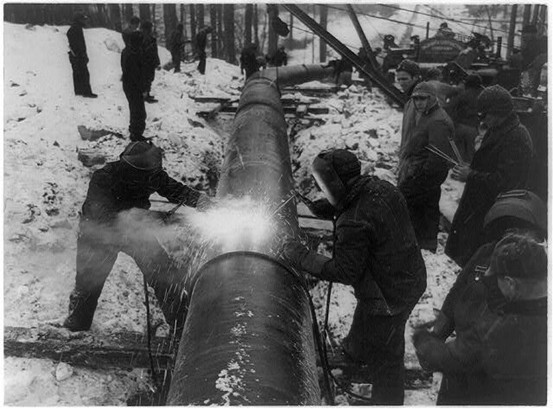Pipelines of Power: The Political Economy of the “Big Inch” and “Little Big Inch” during the Second World War and their Postwar Legacy

During the Second World War, the federal government of the United States collaborated with several companies to construct two oil pipelines, known as the ‘Big Inch’ and the ‘Little Big Inch’. These pipelines extended directly from Texas to New York and Philadelphia, serving both to secure petroleum supplies for New England and to support the provision of oil aid abroad. Public officials branded them as ‘patriotic projects’, but in fact, they belonged to the Interior Department’s broader energy agenda. These pipelines not only stirred heated social tensions during the war but also reshaped how Americans consumed energy at home and how the USA managed its oil business abroad in the postwar era. My recent article, ‘Pipelines of Power: The Political Economy of the "Big Inch" and "Little Big Inch" during the Second World War and Their Postwar Legacy', examined the trajectory of energy transition driven by the pipelines and revealed the shifting configurations of power that accompanied it.
A ‘Fragile’ Energy System
In the first half of the twentieth century, the USA entered the ‘petroleum age’ and gradually formed a Southwest–Northeast pattern of petroleum transport. Within that system, 95 percent of petroleum shipments relied on tankers along the Houston–New York route. The limits of this single-channel structure contributed to wartime energy shortages. At the same time, John L. Lewis, President of the United Mine Workers of America, who excelled at leading strikes and creating ‘coal shortages’, dominated the coal industry in the American Northeast. At the same time, railroad and coal interests prevented the widespread adoption of natural gas in the Northeast until the eve of the Second World War. Against this backdrop, the Secretary of the Interior Harold Ickes proposed the idea of constructing one or more pipelines to connect the oil fields of the Southwest with the markets of the Northeast; however, this was not sanctioned by President Roosevelt and so came to nothing at this time.
The photo shows welders working on the pipeline, 1943.
Oil for Britain, Doubts at Home
As a result of the 1941 Lend-Lease Act the USA began supplying Britain and the other Allies with food, oil, materiel, and oil. Tankers that ran from the Port of Houston to the Port of New York not only carried the task of delivering petroleum to the American Northeast but also bore the responsibility of supplying Britain and other Allies. Yet America’s petroleum aid abroad further intensified the strains within the domestic energy system. People began to complain that these shipments directly caused shortages of petroleum in the Northeast. While Ickes continued to send petroleum overseas, he also enforced rationing at home, and this dual policy turned his pipeline proposal into what critics called a conspiracy.
War as a Catalyst
At the end of 1941, America’s entry into the war drew German submarines, once concentrated in the North Atlantic and the Mediterranean, into the South Atlantic, and they even pressed close to the Gulf of Mexico to attack American tankers. These assaults directly harmed the economic interests of American petroleum producers and threatened the personal welfare and basic livelihood of ordinary citizens. For this reason, the pipeline plan, which carried the hope of restarting factories and heating homes, gradually gained support. The government and eleven petroleum companies together settled on the construction of two pipelines from the Houston area in Texas to New York and Philadelphia, known as the ‘Big Inch’ and the ‘Little Big Inch’.
Wartime Pipelines Still in Operation
The ‘Big Inch’ and the ‘Little Big Inch’ not only supplied petroleum to the American Northeast during the war but also reshaped America’s energy society in the postwar years. On November 11, 1947, the government auctioned the pipelines as surplus wartime property to the Texas Eastern Transmission Corporation. The company used the geographic advantage of the ‘Big Inch’ and the ‘Little Big Inch’ to bring natural gas first into the Appalachian region and later into Philadelphia and New York. This expansion gradually displaced coal gas in the energy market and weakened John L. Lewis and his union. Moreover, the Department of the Interior relied on the ‘Little Big Inch Division’ of Texas Eastern as a ‘bridgehead’ and thus took part indirectly in overseas petroleum projects such as the NATO and Central European Pipeline Plan and the Mary Gas Pipeline in West Pakistan and India. An important consequence was that US private companies increasingly served as instruments for carrying out America’s overseas energy policy during the Cold War.

